Key takeaways:
- Slow cooking enhances flavors and transforms tough cuts of meat into tender, flavorful dishes through low heat and extended cooking times.
- Key tools for successful slow cooking include a quality slow cooker, sharp kitchen knives for easy prep, and airtight containers for storage.
- Common mistakes in slow cooking involve overloading the pot, cooking at too high a temperature, and not allowing enough time for flavors to develop.
- Personal experiences highlight the joys and challenges of slow cooking, emphasizing the importance of patience, tasting, and adjusting flavors during the cooking process.
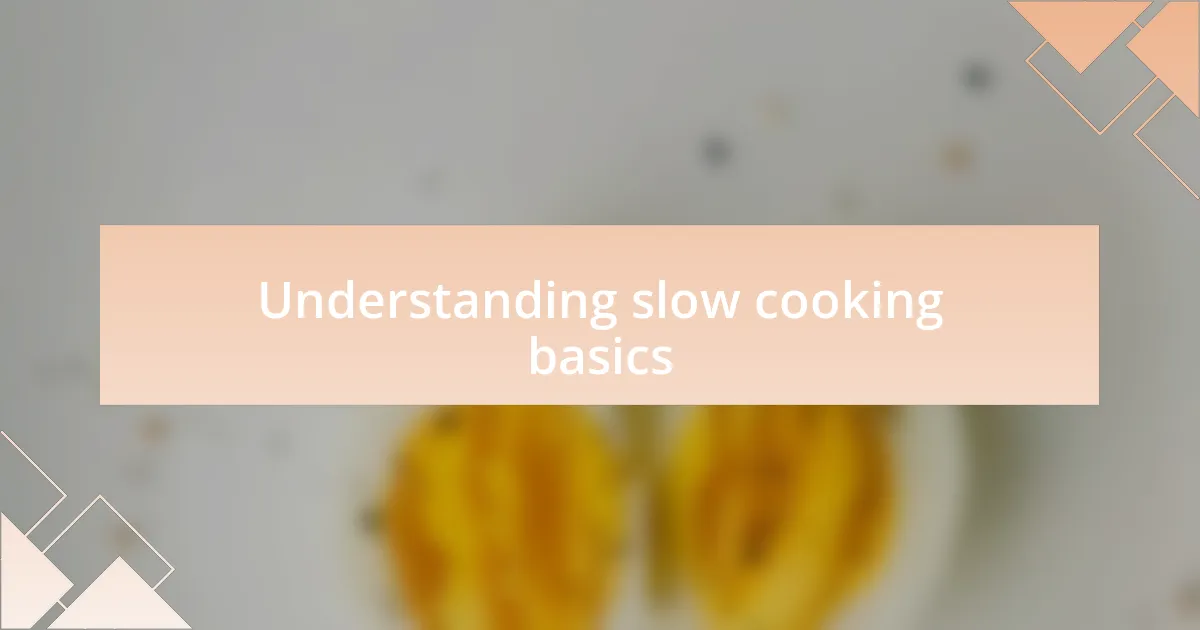
Understanding slow cooking basics
Slow cooking is all about transforming ingredients over time, allowing flavors to meld and deepen. I remember the first time I used a slow cooker; I tossed in some simple vegetables and a cut of meat in the morning, and by dinner, I was greeted with a robust, savory aroma that filled my home. Isn’t it fascinating how patience can yield such incredible results in the kitchen?
At its core, slow cooking is a gentle method that uses low heat over an extended period. This technique breaks down tough cuts of meat and allows spices to infuse rich flavors into every ingredient. I’ve learned that the difference in texture and taste is striking; it’s like the ingredients have had a chance to bond and truly express themselves.
When considering slow cooking, it’s essential to understand the importance of timing and temperature. Finding that perfect balance can sometimes be a challenge. Have you ever opened your slow cooker to find a meal that’s a bit dry? I know I have, which taught me to pay closer attention to the liquid levels and cooking duration. It’s all part of the learning process, turning cooking into an art form as much as a science.
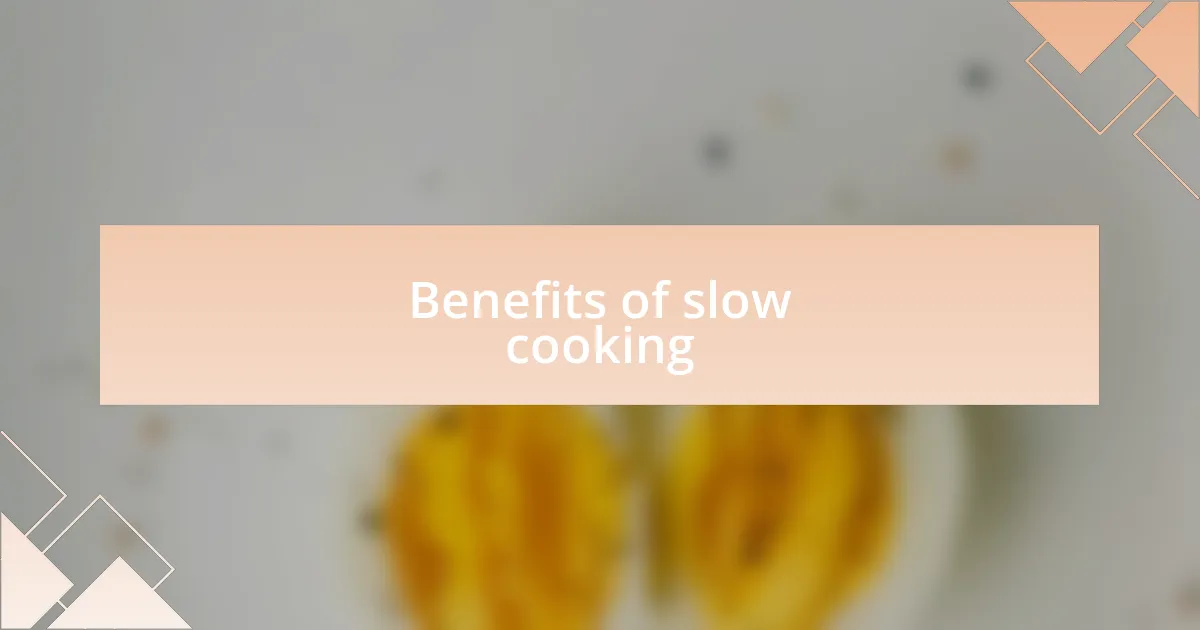
Benefits of slow cooking
The benefits of slow cooking are truly remarkable. One of the standout advantages is the depth of flavor it brings to dishes. I remember preparing a beef stew on a chilly Sunday afternoon. As it simmered for hours, the aroma wafting through my home was nothing short of comforting. It struck me how the longer cooking time allowed the spices to evolve, creating a complex taste that simply couldn’t be rushed.
Another significant benefit is the ease and convenience it offers. I’ve found that when life gets hectic, tossing ingredients into a slow cooker feels like a lifesaver. Knowing I can set it in the morning and come back to a ready meal in the evening gives me such peace of mind. Have you ever felt overwhelmed by meal prep? With slow cooking, there’s no frantic last-minute dash to the kitchen.
Additionally, this method is a budget-friendly way to maximize the use of tougher cuts of meat. I recall a time when I took a chance on a rather inexpensive cut; by the end of the cooking process, it had transformed into something melt-in-your-mouth delicious. It’s satisfying to realize that slow cooking not only enhances meals but can also save money while providing wholesome, hearty options for families.
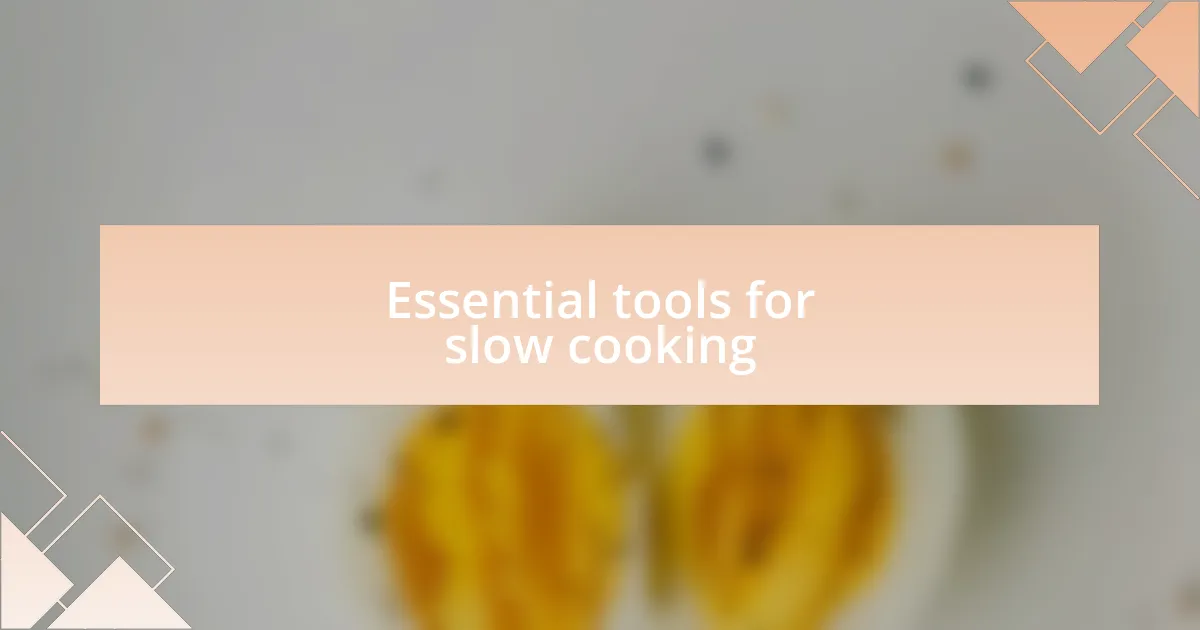
Essential tools for slow cooking
When it comes to slow cooking, having the right tools can truly elevate the experience. A quality slow cooker is essential; I’ve found that a programmable model gives me the freedom to set the cooking time and temperature, ensuring consistent results every time. Can you picture coming home after a long day to a perfectly cooked meal waiting for you?
Alongside the slow cooker, an excellent set of kitchen knives can make prep work smoother. I vividly remember the first time I struggled with a dull knife while chopping vegetables for a hearty soup. I learned the hard way that a sharp knife not only speeds up the process but also makes slicing and dicing much safer and more enjoyable. Investing in good knives is like treating yourself to a culinary upgrade – it can transform the entire cooking experience.
Lastly, I can’t emphasize enough the importance of quality airtight containers. These come in handy when you’re storing leftover food or prepped ingredients for the week ahead. Last month, I had some pulled pork leftover and kept it in a sturdy container. A few days later, when I pulled it out, the flavors had melded even further, making my next meal just as scrumptious as the first. It’s those little moments that make slow cooking feel rewarding!
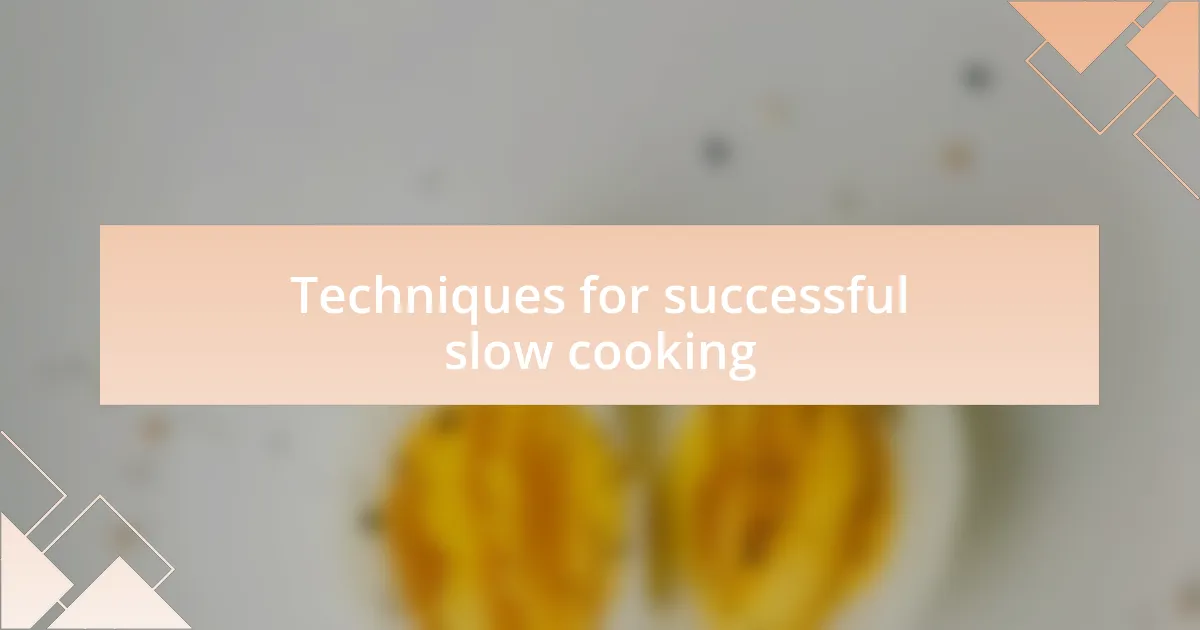
Techniques for successful slow cooking
When venturing into slow cooking, mastering layering flavors is key to building a dish that truly sings. I’ve discovered that browning meats and sautéing vegetables before they hit the slow cooker creates a depth of flavor that simply simmering doesn’t achieve. Remember that simmering isn’t just about cooking; it’s about coaxing out the best in your ingredients. Does anyone else enjoy that moment when you can practically taste the anticipation of a dish just by the aromas wafting through the kitchen?
Another technique I’ve found invaluable is knowing when to add ingredients. For instance, heartier vegetables like carrots and potatoes should go in at the beginning, while delicate ingredients, such as fresh herbs or dairy, are best added at the end. I still recall the time I tossed in spinach too early, resulting in a lackluster green mush. It taught me that timing plays a crucial role in ensuring each component shines in its own right while contributing to the harmony of the dish.
Lastly, don’t underestimate the power of adjusting liquid. Slow cooking tends to retain moisture, so I often find myself cutting back on liquids compared to traditional cooking methods. One time, I was hesitant to reduce the broth for a stew, fearing it would dry out. To my surprise, not only did the flavors concentrate beautifully, but the dish turned out rich and satisfying. It’s all about that delightful balance, wouldn’t you agree?

Common slow cooking mistakes
One of the most common mistakes I’ve encountered in slow cooking is overloading the pot, thinking more ingredients equal better flavor. I remember a time I packed my slow cooker to the brim, only to find my dish was more of a soggy mush than a cohesive meal. This taught me the hard way that each ingredient needs space to shine, so I now stick to recommended volumes for optimal results.
Another pitfall is cooking at too high a temperature. I distinctly recall that one holiday dinner where I rushed things by setting the cooker too high, hoping to save time. While the roast eventually cooked, it turned out dry and tough, quite the disappointment for the festive gathering. I’ve since learned that patience is truly a virtue in slow cooking, and that low, steady heat yields the best tender and flavorful outcomes.
Lastly, not allowing enough time for the flavors to develop can be detrimental. I vividly remember a day when I was impatient for that beef stew, thinking it would taste just fine after only a few hours. It was a letdown—the flavors hadn’t melded as I envisioned, leading to a meal that was far from memorable. Now, I ensure to plan ahead, allowing my dishes the time they need to become truly exceptional.
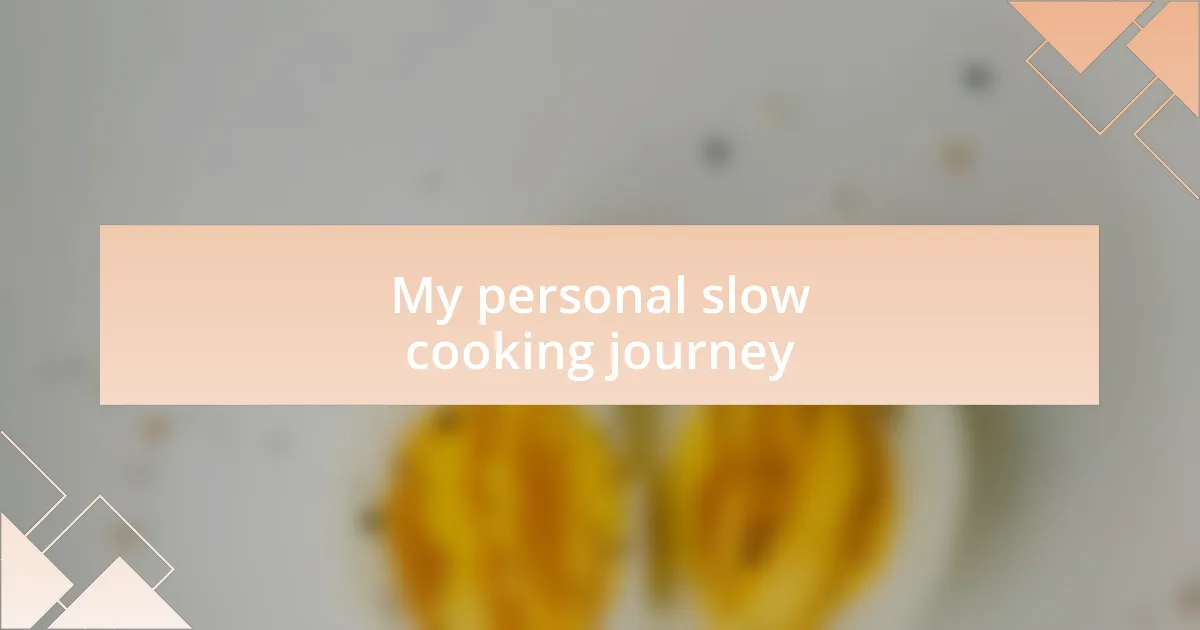
My personal slow cooking journey
I remember when I first embraced slow cooking. It felt like something out of a cozy storybook, where a delicious aroma would waft through my home as I went about my day. I still cherish those moments when I’d return from a long day to find something like a savory pot roast waiting for me, perfectly tender and full of rich flavors. How could something that required so little effort provide such comfort?
As I navigated my slow cooking adventure, I encountered my fair share of surprises. One particular instance stands out — I set out to make a hearty chili, confident in my ingredients. But it wasn’t until I tasted it after hours of cooking that I realized my error: I had neglected to season properly. The disappointment was palpable, and I found myself asking, “How did I let such a simple oversight happen?” This experience taught me to embrace the practice of tasting and adjusting throughout the cooking process.
Now, slow cooking feels like a nurturing experience. Each time I use my slow cooker, I think of the lessons learned and how it has transformed my view on cooking itself. I find joy in preparing a dish the night before, tucking it into the cooker, and allowing it to simmer overnight. There’s something profoundly rewarding in waking up to the promise of a meal that has evolved while I slept; it’s almost like a culinary trust in the magic of time.
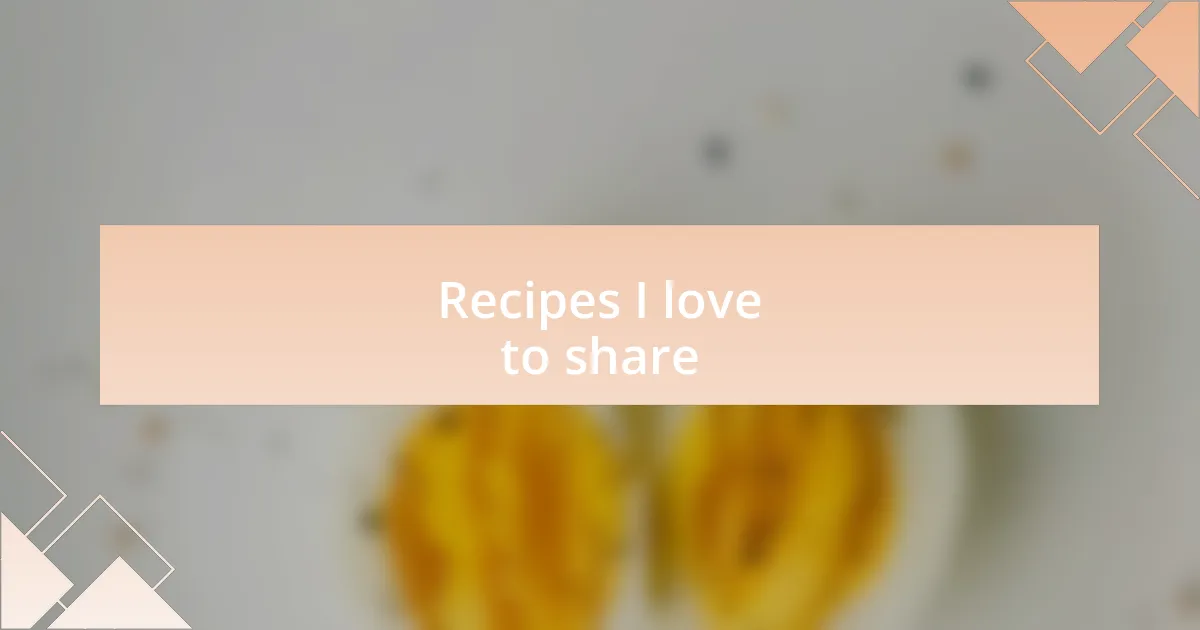
Recipes I love to share
I absolutely love sharing my slow-cooked pulled pork recipe. It’s a crowd-pleaser that transforms a simple pork shoulder into a tender masterpiece soaked in tangy barbecue sauce. There’s something thrilling about watching friends dive into the dish, each bite accompanied by laughter and stories ignited by good food. Isn’t it amazing how a single recipe can create such memorable moments?
Another favorite of mine is my slow-cooked vegetable stew. I often add whatever leftovers I have in the fridge, turning what might be waste into a colorful, wholesome meal. The mix of flavors and textures always surprises me — who knew such a creative dish could come from clearing out my pantry? I can’t help but smile when I serve it, inviting others to discover their own favorite combinations.
And then there’s my obsession with overnight oats made in the slow cooker. I still remember the first time I woke up to that delicious aroma, the oatmeal perfectly creamy and infused with cinnamon and apples. It felt like waking up to a warm hug, and I’ve loved offering this simple breakfast solution to friends and family. Who wouldn’t want to start their day with something so comforting and nutritious?